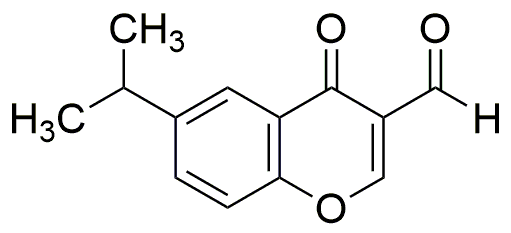3-Formyl-6-isopropylchromone is widely utilized in research focused on:
- Pharmaceutical Development: This compound serves as a key intermediate in synthesizing various bioactive molecules, particularly in the development of new drugs targeting cancer and inflammatory diseases.
- Natural Product Synthesis: It is employed in the synthesis of natural products, allowing researchers to create compounds that mimic or enhance the effects of naturally occurring substances.
- Material Science: The unique properties of this compound make it suitable for developing advanced materials, including polymers and coatings that require specific optical or electronic characteristics.
- Analytical Chemistry: It is used as a standard in analytical methods, helping researchers to accurately quantify and analyze similar compounds in complex mixtures.
- Biological Research: The compound is studied for its potential antioxidant and antimicrobial properties, providing insights into new therapeutic applications and enhancing our understanding of biological processes.
Informations générales
Propriétés
Sécurité et réglementation
Applications
3-Formyl-6-isopropylchromone is widely utilized in research focused on:
- Pharmaceutical Development: This compound serves as a key intermediate in synthesizing various bioactive molecules, particularly in the development of new drugs targeting cancer and inflammatory diseases.
- Natural Product Synthesis: It is employed in the synthesis of natural products, allowing researchers to create compounds that mimic or enhance the effects of naturally occurring substances.
- Material Science: The unique properties of this compound make it suitable for developing advanced materials, including polymers and coatings that require specific optical or electronic characteristics.
- Analytical Chemistry: It is used as a standard in analytical methods, helping researchers to accurately quantify and analyze similar compounds in complex mixtures.
- Biological Research: The compound is studied for its potential antioxidant and antimicrobial properties, providing insights into new therapeutic applications and enhancing our understanding of biological processes.
Documents
Fiches de données de sécurité (FDS)
La FDS fournit des informations de sécurité complètes sur la manipulation, le stockage et l’élimination du produit.
Spécifications du produit (PS)
Le PS fournit une description complète des propriétés du produit, notamment sa composition chimique, son état physique, sa pureté et les exigences de stockage. Il détaille également les plages de qualité acceptables et les applications prévues du produit.
Certificats d'analyse (COA)
Recherchez des certificats d'analyse (COA) en saisissant le numéro de lot du produit. Les numéros de lot et de lot se trouvent sur l'étiquette d'un produit, après les mots « Lot » ou « Lot de fabrication ».
Numéro de catalogue
Numéro de lot/série
Certificats d'origine (COO)
Ce certificat d'exploitation confirme le pays dans lequel le produit a été fabriqué, et détaille également les matériaux et composants utilisés et s'il est issu de sources naturelles, synthétiques ou autres sources spécifiques. Ce certificat peut être requis pour les douanes, le commerce et la conformité réglementaire.
Numéro de catalogue
Numéro de lot/série
Fiches de données de sécurité (FDS)
La FDS fournit des informations de sécurité complètes sur la manipulation, le stockage et l’élimination du produit.
DownloadSpécifications du produit (PS)
Le PS fournit une description complète des propriétés du produit, notamment sa composition chimique, son état physique, sa pureté et les exigences de stockage. Il détaille également les plages de qualité acceptables et les applications prévues du produit.
DownloadCertificats d'analyse (COA)
Recherchez des certificats d'analyse (COA) en saisissant le numéro de lot du produit. Les numéros de lot et de lot se trouvent sur l'étiquette d'un produit, après les mots « Lot » ou « Lot de fabrication ».
Numéro de catalogue
Numéro de lot/série
Certificats d'origine (COO)
Ce certificat d'exploitation confirme le pays dans lequel le produit a été fabriqué, et détaille également les matériaux et composants utilisés et s'il est issu de sources naturelles, synthétiques ou autres sources spécifiques. Ce certificat peut être requis pour les douanes, le commerce et la conformité réglementaire.


